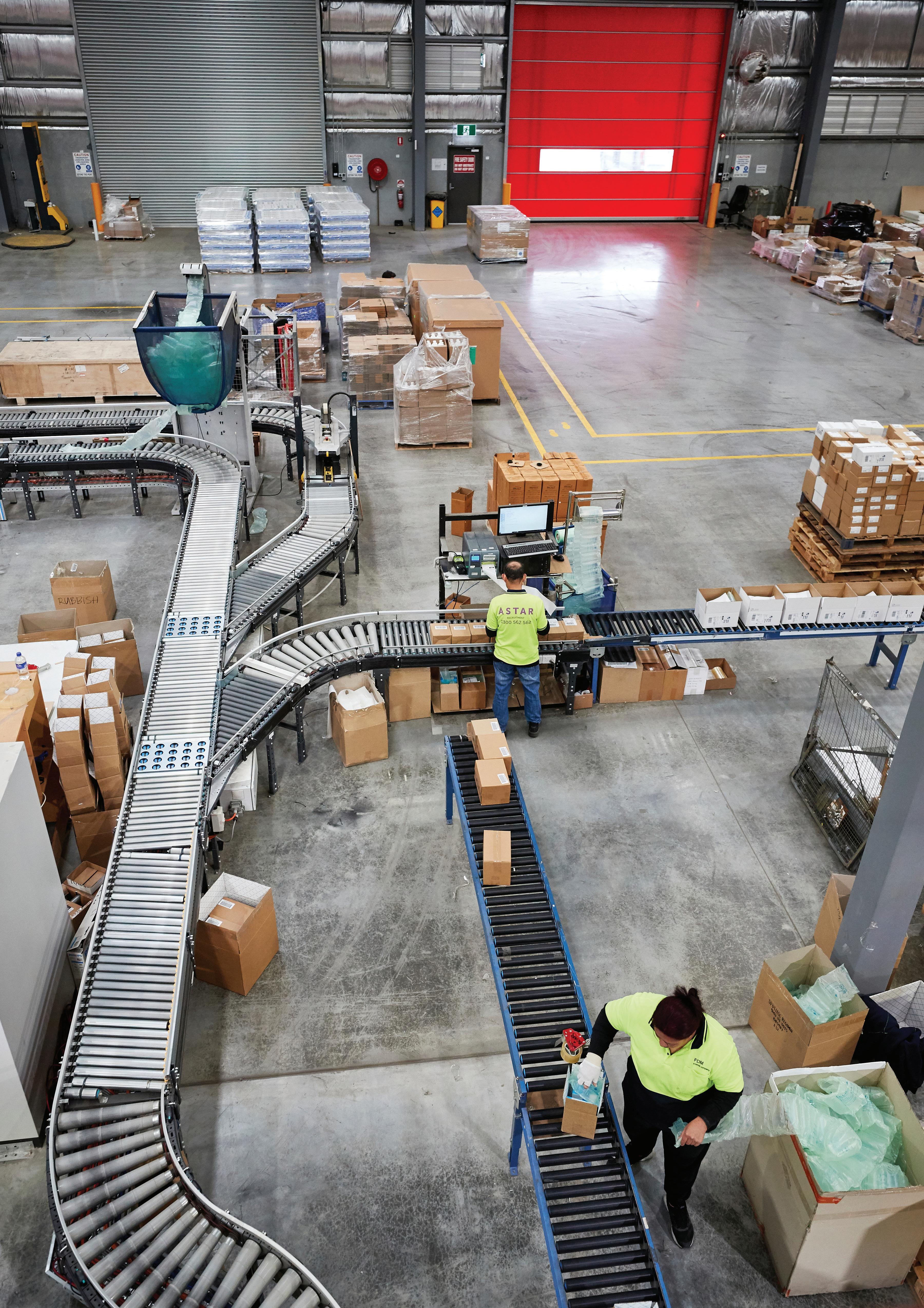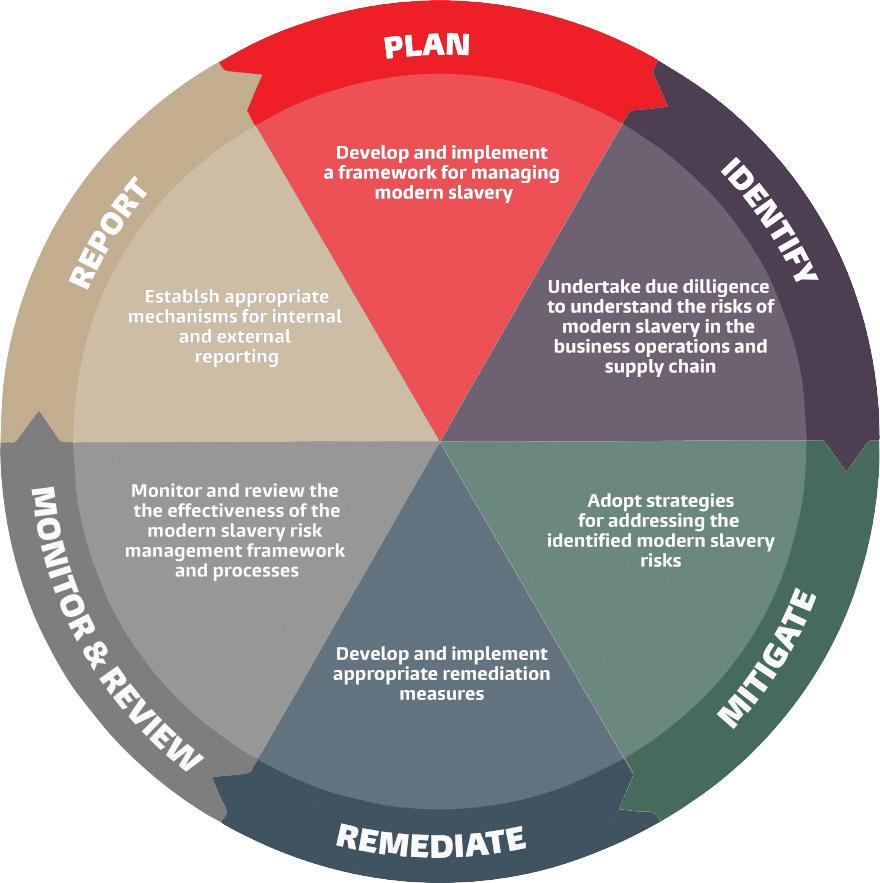
9 minute read
Structure & Operations
MODERN SLAVERY RISKS
The Global Context
The term modern slavery is used to describe situations where coercion, threats or deception are used to exploit victims and undermine or deprive them of their freedom. The Modern Slavery Act 2018 (Cth) defines modern slavery as including eight types of serious exploitation: trafficking in persons, slavery, servitude, forced marriage, forced labour, debt bondage, deceptive recruiting for labour or services, and the worst forms of child labour1 .
Globally, there is an estimated 40.3 million victims of modern slavery as at 20162. Approximately 18% of these modern slavery victims are in the construction industry and 22% of forced labour victims are involved in the manufacturing and production of raw materials, which are key supplies for the property and construction sector3. The property and construction industries are especially vulnerable to modern slavery due to the high demand for low-skilled labour, a lack of visibility of the complex and extensive supply chains, and the vast number of low-tier suppliers operating in high-risk locations4. This is evident in the supply chains of solar panels and personal protective equipment, which have been flagged as having significantly high volumes of modern slavery.
Solar Energy Risks
The manufacturing of solar modules has recently emerged as an industry at high risk of modern slavery, particularly in the Xinjiang Uyghur Autonomous Region5. As a property developer, owner and manager who engages with solar panel suppliers, we know that steps need to be taken to address these risks within our supply chains. As this is an emerging concern with risks reaching well beyond our direct suppliers, we have yet to delve into addressing these risks. This is one of our priorities for FY22, and we will continue to work closely with internal stakeholders and industry experts to develop an approach to mitigating the risk of modern slavery in this industry.
The Australian Context
In Australia, it is estimated that there are 15,000 people living in conditions of modern slavery as at 20166. While this is comparatively low compared to many other regions in the world, a more concerning figure is that only 1 in 5 of these victims are identified7. Most modern slavery cases in Australia involve migrants, as they are particularly susceptible due to the inherent vulnerabilities of low-skilled temporary migration8. This is likely to increase over time, not only in Australia, but globally, as the impacts of climate change and political conflict evolve.
The Modern Slavery Act 2018 (Cth) aims to address these issues by requiring specific entities with operations in Australia to report on the actions they are taking to mitigate and remediate modern slavery in their operations and supply chains.
1. The Department of Home Affairs (2019). Commonwealth Modern Slavery Act 2018 Guidance for Reporting Entities. [online] Available at: https://www.homeaffairs. gov.au/criminal-justice/files/modern-slavery-reporting-entities.pdf. 2. International Labour Organization (2018). Forced labour, Modern Slavery and Human Trafficking (Forced labour, Modern Slavery and Human trafficking). [online]
Ilo.org. Available at: https://www.ilo.org/global/topics/forced-labour/lang--en/index.htm. 3. Australian Human Rights Commission and KPMG Banarra (2020). Property, Construction and Modern Slavery (2020) | Australian Human Rights Commission. [online] humanrights.gov.au. Available at: https://humanrights.gov.au/our-work/business-and-human-rights/publications/property-construction-and-modernslavery-2020. 4. Australian Human Rights Commission and KPMG Banarra (2020). Property, Construction and Modern Slavery (2020) | Australian Human Rights Commission. [online] humanrights.gov.au. Available at: https://humanrights.gov.au/our-work/business-and-human-rights/publications/property-construction-and-modernslavery-2020. 5. Murphy, L. and Elimä, N. (2021). In Broad Daylight Uyghur Forced Labour in the Solar Supply Chain | Sheffield Hallam University. [online] www.shu.ac.uk. Available at: https://www.shu.ac.uk/helena-kennedy-centre-international-justice/research-and-projects/all-projects/in-broad-daylight. 6. Australian Human Rights Commission and KPMG Australia (2021). Combatting modern slavery in the health services sector. [online] humanrights.gov.au.
Available at: https://humanrights.gov.au/about/news/combatting-modern-slavery-health-services-sector. 7. Anti-Slavery Australia (2016). Modern Slavery | Anti Slavery Australia. [online] Antislavery.org.au. Available at: https://antislavery.org.au/modern-slavery/. 8. Global Slavery Index (2019). Australia | Global Slavery Index. [online] Globalslaveryindex.org. Available at: https://www.globalslaveryindex.org/2018/findings/ country-studies/australia/. MODERN SLAVERY RISKS
Our Modern Slavery Risks
At Frasers Property, most of our workforce is employed directly through our People and Culture Team, which significantly lowers the risk of modern slavery within our operations. We do occasionally employ temporary staff via recruitment agencies for short-term engagements; however, these employees are vetted internally prior to engagement. To ensure that our employees are aware of their rights, all staff are provided with access to and training on our policies and procedures relating to employment, which are regularly reviewed and updated in line with current legislation and best practice.
The risk of modern slavery is significantly higher in our supply chain, particularly in situations where we outsource our operational functions and delivery processes, as we have less direct visibility and control over the procurement of materials and the employment of workers. Although most of our direct suppliers are Australian businesses, we are aware that their supply chains may extend outside Australian borders, which increases the risk of modern slavery in Tier 2 and beyond of our supply chain.
The services we procure that are particularly vulnerable to modern slavery include security, cleaning, waste management, and trade works, while the procurement of branded and unbranded goods, carpet, concrete, bathroom materials, timber and lumber, and windows have been identified as high-risk materials for our business. Details of the process undertaken to identify these high-risk goods and services can be found in the following section on page 16.
As we further develop our understanding of and approach to reducing the risks of modern slavery, we will expand our scope beyond our direct suppliers and begin exploring the risks of modern slavery further down our supply chain.
COVID-19 Impacts
COVID-19 has created unprecedented challenges for businesses globally and has disrupted operations in ways that have increased worker’s vulnerability and exposure to modern slavery9. For Frasers Property, the more frequent need for essential services such as cleaning and security, and the increase in demand of IT equipment and furniture due to working from home arrangements are just a few ways in which our exposure to modern slavery risks in our supply chain has increased as a result of COVID-19. Regardless of these impacts, our values are unchanging, and working towards establishing a responsible supply chain continues to be a priority for our business.
We are also conscious of the adverse impacts that our suppliers continue to face as they adapt to the ever-changing effects of this global pandemic. Frasers Property will continue to support our suppliers during this difficult time and ensure that together, we continue to address the risks of modern slavery.
MANAGING OUR RISKS
Our approach to managing modern slavery risks follows a robust methodology for identifying, mitigating, and remediating modern slavery risks, and assessing the effectiveness of these actions. This approach, which has been informed by our engagement with industry experts in 2018 and best practice management, is reflected below in our Modern Slavery Risk Management Framework.
Frasers Property’s Modern Slavery Risk Management Framework

Plan
To support our approach to managing modern slavery risks at Frasers Property, we have a comprehensive set of policies and procedures that articulate our values, ways of working and expectations of employees and suppliers. These documents ensure that our employees and suppliers clearly understand our expectations, commitments, and processes.
The newest addition to this set of documents is our Responsible Sourcing Policy, which was published in March 2021. This policy clearly stipulates our commitment to producing goods and services responsibly, as well as our expectations of suppliers. In FY22, we will also be revising our Modern Slavery Risk Procedure, which details our approach to managing modern slavery risks.
MANAGING OUR RISKS
Our policies and procedures as relevant to human rights and modern slavery
Policy or Procedure Purpose
Anti-Bribery Policy Sets out the policies and procedures that have been put in place to prevent the occurrence of bribery and corruption. Frasers Property has a zero-tolerance approach to bribery and corruption.
Code of Business Conduct
Corporate Social Responsibility Policy
Grievance & Dispute Resolution Policy Provides clear guidelines on ethics and relationships, thereby safeguarding the reputation and interests of Frasers Property and our stakeholders and governing the conduct of every employee.
Reflects our commitment to create places where resources are reused, recycled, and restored, and where new ideas are fostered to support people and the planet, and initiatives are taken to help people lead better, healthier lives.
Stipulates how employees may raise and discuss work-related matters of concern with a view to resolving issues as quickly as possible.
Guide to Making a Disclosure
HSE Incident Management Explains how employees or officers of Frasers Property can make a report under the Whistle-blower Policy. This Guide should be read in conjunction with the Whistle-blower Policy.
Defines the minimum requirements for responding, reporting, investigating, and managing Health, Safety and Environment (HSE) incidents.
HSE Risk Management Defines the minimum requirements for the effective and consistent identification, assessment, control and review of HSE hazards and risks.
Modern Slavery Risk Procedure Sets out our approach to identifying and managing modern slavery risks in relation to our direct procurement of all goods and services.
Responsible Sourcing Policy Communicates Frasers Property’s commitment to procuring goods and services responsibly and our expectations of suppliers in this regard.
Risk Management Policy Seeks to identify, assess, monitor, and manage risks across the organisation. Frasers Property will ensure that risk management is an integral part of our decision-making process and will use risk management to take advantage of potential opportunities while managing potential adverse effects.
Whistle-blower Policy Details the framework for receiving, investigating, and addressing allegations of criminal, dishonest or unethical behaviour where that behaviour concerns the activities of Frasers Property or current and former directors, officers, agents, employees and contractors of Frasers Property. MANAGING OUR RISKS
Identify
In 2016, as part of the sustainability commitments outlined in our A Different Way strategy, Frasers Property conducted an assessment and mapping exercise of our supply chain to better understand key risks and opportunities, and to identify how best to work with our suppliers to manage environmental and safety hazards. Through this exercise we identified three modern slavery practices that pose the greatest risk to our supply chain: forced labour, debt bondage, and deceptive recruiting for labour, and key recommendations to work towards reducing these risks.
High risk modern slavery practices
Forced labour
Restrictions of movement, intimidation, threats, including human trafficking.
Debt Bondage
The payment of excessive recruitment fees or associated costs, and retention of identity documents.
Deceptive recruiting for labour
Workers falsely promised certain jobs, benefits or conditions.
In 2018, Frasers Property engaged an industry expert to design an approach to implement these recommendations. The objective of this project was to establish a responsible sourcing commitment, integrate responsible sourcing considerations into procurement, and to use this process to increase awareness and capacity amongst key stakeholders, including employees and suppliers.
Over the course of the engagement, key stakeholders across Frasers Property were consulted at multiple stages. This included interviews with ten internal stakeholders across six different divisions in the business, the facilitation of a policy commitment workshop and a supplier management model validation workshop, as well as a project review meeting.
As part of this work, a risk assessment of the products and services that we procure through our direct suppliers was undertaken, in which ten product and service categories were identified as high risk based on extent of environmental impact, reputational risk to Frasers Property, and known labour risk factors.



